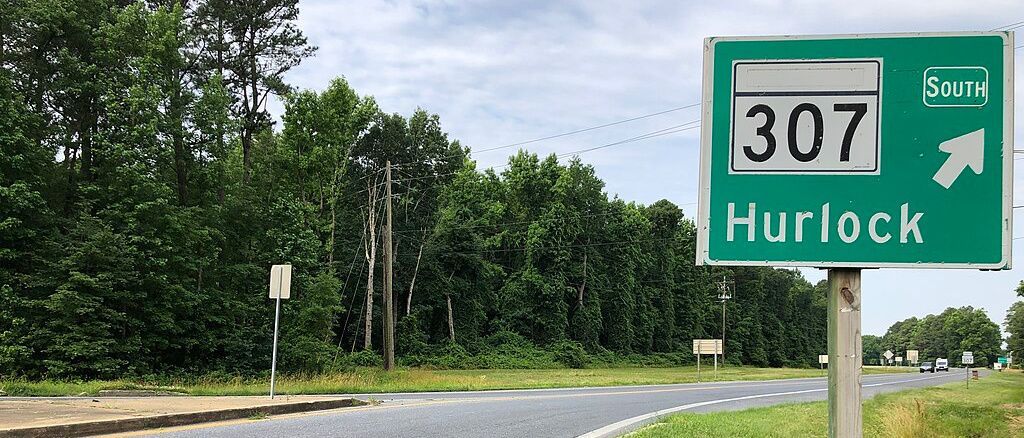Maryland is Still Losing Forests and Trees, Though at a Slower Rate, Study Finds

Maryland’s forest loss has slowed considerably in the past decade, a new study shows. But development is still claiming chunks of woodlands around the state, especially in the rapidly growing suburbs of Washington, D.C. And the forest that remains is so carved up that it’s declining in ecological value and threatened by invasive species.
High-resolution aerial surveys show a net statewide forest loss of more than 19,000 acres from 2013 through 2018, according to the study produced by the Harry R. Hughes Center for Agro-Ecology of the University of Maryland.
All but one region lost forest, while the two counties bordering the District — Prince George’s and Montgomery — together accounted for nearly half of the statewide total.
Development historically has been the leading cause of forest loss, and it still is, the study says, though some woodlands in coastal counties have converted to wetlands, a result of rising sea level from climate change.
The forest losses have been partially offset by an increase in acreage with a more dispersed leafy canopy, which the study said could reflect greening of previously tree-less communities with new plantings. But much of that increase, it added, also reflects the clearing of woodlands by development that’s left scattered clumps of trees.
Commissioned three years ago by the General Assembly, the study’s findings seem likely to renew efforts to strengthen local and state forest conservation laws. State lawmakers demanded an in-depth assessment after legislation stalled in 2018 amid debate over whether Maryland was, in fact, losing forest to development. At that time, the Department of Natural Resources maintained that the state’s woodlands were on the rebound.
The Hughes Center collaborated with the nonprofit Chesapeake Conservancy and the University of Vermont to analyze trends in forest and tree canopy from high-resolution aerial surveys conducted in 2013 and again in 2018. They also consulted satellite imagery, ground observations, and other research.
The study notes that the rate of Maryland’s woodland loss, which had been significant 20 years ago, has trended more recently “toward stabilization.”
From 1999 through 2019, Maryland’s forested acreage shrank by 118,000 acres, an annual loss of nearly 6,000 acres, according to surveys by the U.S. Forest Service. The high-resolution aerial surveys in 2013 and 2018 found the loss rate had decreased by about a third to approximately 3,800 acres a year. About half of those annual losses are directly caused by development, the study found, with much of the rest claimed by natural causes, including storms, diseases, and destructive insects.
Forests still cover about 2.5 million acres, roughly 40% of the state, the study estimates.
“It is notable that since 2000, forest loss slowed across Maryland while population grew nearly 17%, and areas of loss are concentrated in a few rapidly growing counties,” said Susan Minnemeyer, the Chesapeake Conservancy’s vice president for climate strategy.
Losses still take a toll
The study says that Maryland’s forest conservation measures have had enough success reducing losses that the state stands a chance to start regaining forest. The Forest Conservation Act passed in 1991 regulates clearing of woodlands for development and requires some replanting, while a 2013 law set a goal of achieving no net loss of forest.
But those who’ve long advocated for stronger forest protections say the study actually shows the shortcomings of those laws and the need for reform.
“Maryland continues to lose forest,” said Erik Fisher, assistant Maryland director for the Chesapeake Bay Foundation, “and this comes after 30 years of forest conservation rules in place, and a decade after Maryland set a goal to stop forest loss.”
The study does note that even though the overall loss of forest and tree canopy is slowing, losses to development and forest fragmentation remain significant, particularly in rapidly urbanizing central Maryland. Six of the state’s 23 counties — Prince George’s, Montgomery, Anne Arundel, Charles, Calvert, and Baltimore — accounted for almost 70% of all tree canopy and forest losses.
“While Maryland’s forest extent is relatively stable, overall forest health is at risk,” the study’s authors said. “An already patchy mosaic of forests has apparently become increasingly fragmented.”
That fragmentation shrinks the deep woods habitat that some plants, birds and other animals need to survive, and it exposes the remaining patches to further declines from invasive vines and insects. Breaking up forestland also reduces its capacity to absorb climate-warming carbon dioxide and soak up water-polluting storm runoff.
Most developed areas of the state also are suffering major tree losses, despite a pledge made in 2014 by Maryland and other Bay watershed jurisdictions to increase urban tree canopy.
In the five-year span from 2013, Maryland’s urban and suburban areas saw a combined net loss in tree canopy of more than 13,000 acres, the Hughes Center said, with the biggest declines in the suburbs of Washington, D.C., and Baltimore. Baltimore and a handful of smaller municipalities bucked the trend, though, with slight increases.
Those findings echo data released recently from the same aerial surveys showing a net loss of 29,000 acres of urban tree canopy across the entire Bay watershed.
Maryland and the other Bay watershed jurisdictions — Virginia, Pennsylvania, Delaware, New York, West Virginia, and the District of Columbia — pledged to increase urban tree canopy across the region by 2,400 acres by 2025.
The study finds that Maryland is also lagging in another Bay restoration commitment. Tree canopy covers about 58% of the state’s river and stream banks, which despite some reported progress is short of the 70% goal set in 2014 by Bay jurisdictions for establishing shoreline buffers. Only eight of Maryland’s 24 counties have achieved the streamside tree coverage target, which is intended to help reduce polluted runoff and improve fish and wildlife habitat.
Looking ahead
Unless something changes, the study suggests that the future bodes more forest losses. Based on population and employment projections and counties’ zoning, the authors project nearly 40,000 acres more forest could be cleared for development between 2025 and 2055. Growing Anne Arundel, Charles, and Harford counties account for nearly half the projected statewide loss.
Anne Arundel and a few other localities have in the last few years adopted forest conservation requirements that are stricter in some ways than the state’s 1991 Forest Conservation Act. Those reforms were too recent to be assessed in this report.
The study suggests that increasing tree planting efforts could help offset some of the losses. State and local governments and private organizations have planted hundreds of thousands of trees in recent years, but those won’t be large enough to matter for years and they haven’t been enough to offset the losses, the study concludes.
It estimated that government and privately funded programs planted 1,854 acres of trees in 2018 and 2019 alone.
Most of those plantings were attributable to the requirements of the 1991 Forest Conservation Act, the study said. It found, though, that “forest mitigation banks” authorized under the law aren’t doing much to restore woodlands lost to development. In such banks, developers can pay to protect or plant trees elsewhere instead of replacing onsite trees their construction has cleared.
Such banks have been set up in 15 Maryland counties to facilitate development. But the study found that developers are paying mainly to protect existing forestland, not plant acres of new trees.
State lawmakers have banned the practice of offsetting development by protecting existing forest until 2024, when it will decide what to do next pending the results of this study.
Maryland’s Tree Solutions Now Act, passed in 2021, offers an opportunity to help reduce canopy losses, the study says. The law calls for planting five million trees statewide by 2031, including 500,000 in underserved, primarily urbanized areas. The study projects that if all of those trees get planted, they would expand the state’s canopy by 12,500 acres. There’s ample open land for placing them, it said.
It could take at least a decade, though, for those newly planted trees to grow large enough to provide significant cover.
Meanwhile, in addition to planting, the study suggests that the most effective reforestation measure would be protecting more existing woodlands. As of 2018, only one-third of Maryland’s forests and 9% of the state’s tree canopy outside of forests were protected by government or private easements, the study notes. Yet overall tree canopy in those protected areas grew by more than 2,200 acres in the preceding five years as trees grew and branched out.
“In order to reverse this [forest loss] trend,” the study’s authors wrote, “the state should prioritize forest protection as a mechanism for not only maintaining, but also increasing, forest area.”
This article was originally published in the Bay Journal, a non-profit news source that provides the public with independent reporting on environmental news and issues in the Chesapeake Bay watershed.
Tim Wheeler is the Bay Journal's associate editor and senior writer, based in Maryland.
Common Sense for the Eastern Shore







